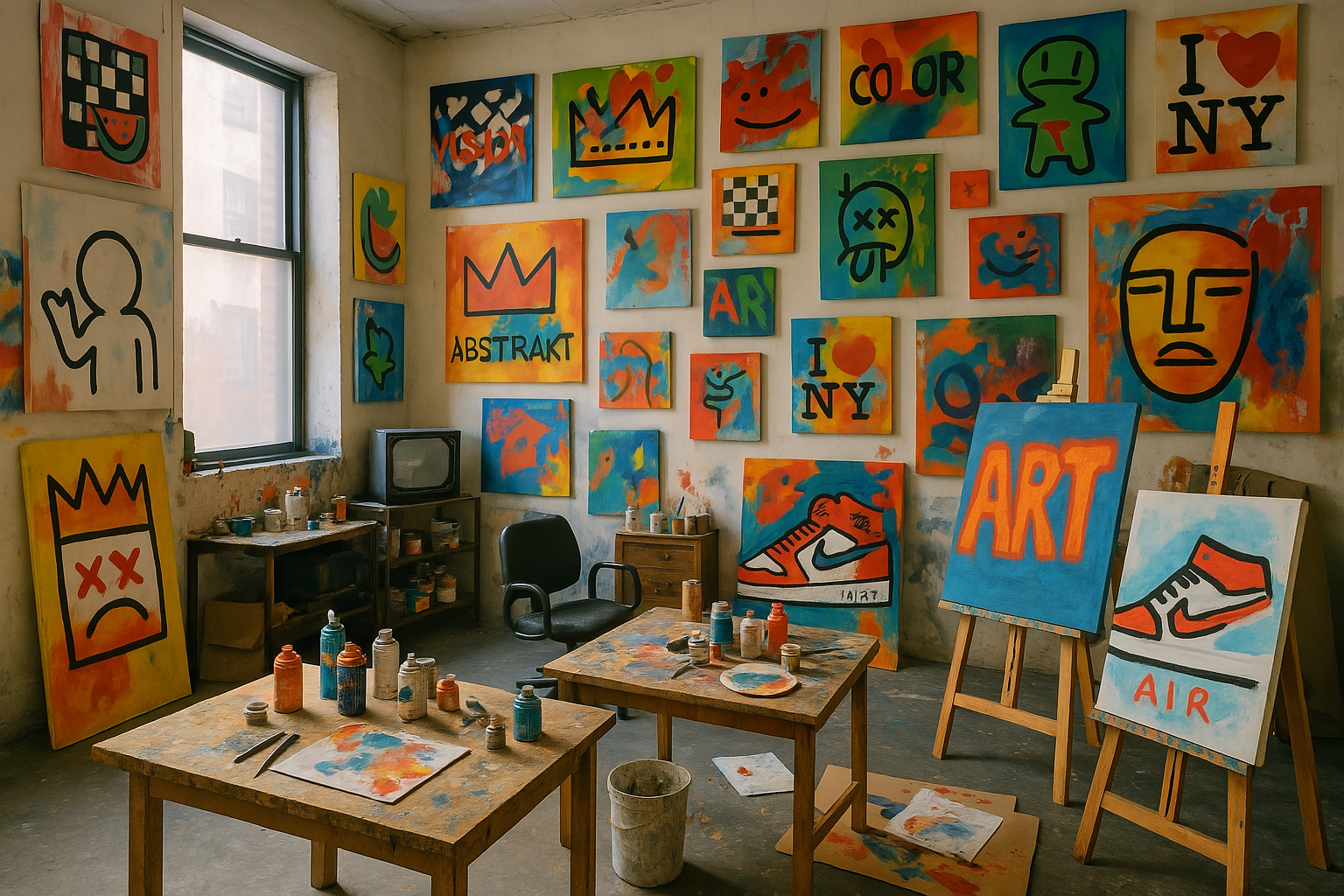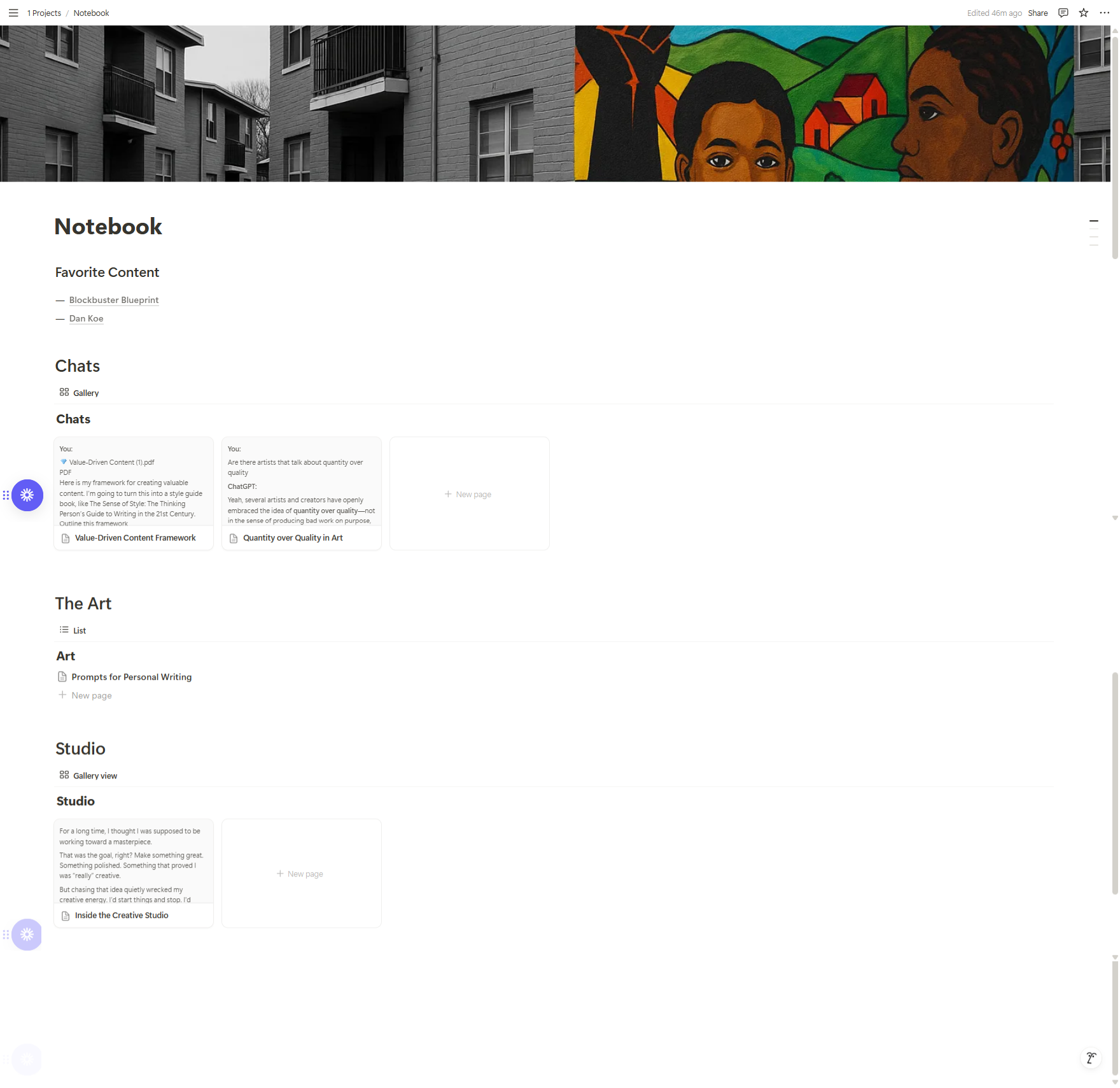For a long time, I thought I was supposed to be working toward a masterpiece.
That was the goal, right? Make something great. Something polished. Something that proved I was “really” creative.
But chasing that idea quietly wrecked my creative energy. I’d start things and stop. I'd judge them halfway through. I kept comparing myself to finished work I enjoyed and wondered why mine never felt the same.
Eventually, I realized the problem wasn’t the work.
It was the model I was using to approach the work.
I didn’t need a masterpiece. I needed a studio.
A place where all the pieces—good, bad, and confusing—could live. A space where the job wasn’t to be brilliant, but just to keep going. Not everything needed to be worth sharing. It just needed to be finished.
Since I made that shift, something unexpected has started to happen:
My best work is finally showing up.
Not because I’m trying harder.
But because I’ve made a place for it to emerge.
This is the idea I’m working through:
What if the art isn’t the masterpiece? What if the art is the process itself?
The Core Shift: You’re Changing the Product
This realization didn’t land all at once.
For a while, I thought I was just struggling with discipline. If I could focus more, plan better, or find the right tool, maybe I’d finally start producing work I was proud of.
But I’m starting to see that maybe the issue isn’t discipline.
Maybe I’ve just been chasing the wrong thing.
I’ve been treating the masterpiece as the product.
That one exceptional creation that could stand on its own—fully formed, brilliant, and worth sharing. The kind of work that would finally make me feel like a “real” creator.
And because of that mindset, every creation started carrying too much weight. If it wasn’t amazing, it didn’t feel worth finishing. So I’d stop. Or stall. Or endlessly tweak something that probably just needed to be done and let go.
But recently, a new idea started taking shape.
What if the masterpiece isn’t the product?
What if the real product is something else entirely?
What if the point is to build a studio—a place where I show up and create, finish things, and let them live?
And what if, over time, from that steady rhythm of making, a few things naturally emerge that are worth sharing?
Things I can eventually gather into a gallery?
I haven’t fully built this yet. I’m still just sitting with the idea.
But the shift feels real.
Instead of chasing greatness, I could start building a space to create freely.
A studio, not a stage.
The Studio

If I’m honest, I’ve never really had a studio. Not in the traditional sense. Not even in a digital one.
I’ve had scattered notes, half-finished documents, abandoned drafts in different folders, and the occasional thing I was proud enough to publish. But I’ve never had a single place where everything I create belongs.
And maybe that’s the point.
The studio, as I’m starting to think about it, isn’t just a physical or digital space. It’s a mental shift. A commitment to finish, not just start. A place where the quality of a creation doesn’t determine whether it deserves to exist.
Some of those creations will be great.
Some will be fine.
Some will be kind of awful.
And that’s okay. That’s the studio’s job—to hold all of it.
The more I sit with this, the more I realize: the studio is not where I prove myself. It’s where I practice being a creator. It’s where I gather momentum. Where I follow ideas, even if I don’t know where they’re going. It’s where I learn to let things be done—without needing them to be perfect.
My draft "Studio" in notion

I’m still figuring out what my studio will look like. Maybe it’s a Notion page. Maybe it’s a folder with finished drafts. Maybe it’s something public, maybe not. But I think the key is this:
It’s a place where everything I finish belongs, regardless of how good I think it is.
That’s the shift I want to lean into.
The Art
Here’s the part that surprised me the most:
The art isn’t the creation.
The art is the act of creating.
I don’t think I ever really understood that before. I was so focused on the outcome—the quality, the reception, the sense of completion—that I missed the fact that most of what makes someone a creator happens in motion.
It’s not the finished thing that defines the work. It’s the process of returning to the studio, again and again, and letting the act of making shape you.
And when I think about it that way, something shifts. The pressure to get it right loosens. The need to be impressive quiets down. What matters more is that I’m in the studio, doing the work—even if I don’t know where it’s going.
That’s the part I’m just starting to see. The process is the art.
Which means the question changes. It’s no longer, “Is this good enough?”
It becomes, “What am I learning as I make this?” or even, “What’s the next thing this leads to?”
Somewhere along the way, I came across this idea: leave the thread loose. Don’t try to wrap everything up. Don’t aim to resolve every question. Let one creation lead to the next. Let the curiosity stay open.
That’s what keeps the art alive. Not control—continuity.
So maybe the work isn’t to perfect something. Maybe it’s just to keep showing up, following the thread, and letting the art reveal itself through the process.
The Gallery
You walk through a art gallery and see five paintings from an artist.
But behind them are a thousand others you’ll never see.
The studio made those five possible.
If the studio is where everything lives, and the process is where the art actually happens—then the gallery, I think, is something quieter.
It’s not the goal.
It’s the result.
The gallery is where the few creations that stand out can go. Not because they’re perfect, but because they carry something true—something I want to share. And that sharing doesn’t have to happen right away. It doesn’t even have to happen often.
What matters is that it happens after the work—not during it. The gallery emerges.
This idea has helped me let go of a lot of pressure. When I was working with the masterpiece mindset, it felt like every creation had to be gallery-ready from the beginning. But now I’m realizing: the gallery emerges from the studio, not the other way around.
Right now, I just want to create.
To finish.
To build a space where the work can live.
And trust that if I keep showing up, the gallery will take care of itself.
Closing
My interest in creativity didn’t come from a class or a book.
It started with a music video.

Years ago, I saw Jay-Z’s Picasso Baby, his adaptation of Marina Abramovic's *The Artist is Present," and something about it just hit me. It was raw and alive and completely unexpected. A performance piece unfolding in real time—collaborative, strange, inspired. I didn’t have the language for it back then, but I remember thinking:
This is art.
That was the spark.
Since then, I’ve started and stopped more creative projects than I can count. I’ve chased perfection, hesitated to share, and questioned whether any of it really mattered. But lately, something has started to shift. Not because I’ve finally figured it all out—but because I’ve started thinking differently about what I’m actually building.
I used to think the goal was to make a masterpiece.
Now, I’m starting to think the real goal is to build a studio.
A space for finished creations, good or bad.
A rhythm of making that lets the art find me in motion.
And maybe, eventually, a gallery that emerges—not because I forced it, but because I kept showing up.
I’m not there yet.
But the idea feels true.
And for now, that’s enough.